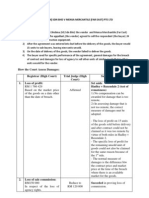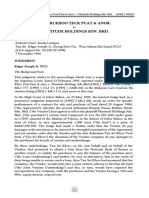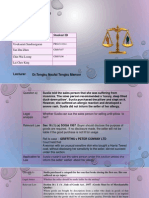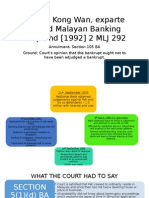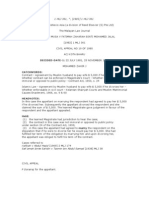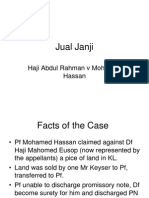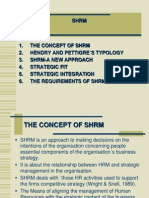Mi & M Corporation & Anor V A Mohamed Ibrahi
Mi & M Corporation & Anor V A Mohamed Ibrahi
Uploaded by
lionheart8888Copyright:
Available Formats
Mi & M Corporation & Anor V A Mohamed Ibrahi
Mi & M Corporation & Anor V A Mohamed Ibrahi
Uploaded by
lionheart8888Original Description:
Original Title
Copyright
Available Formats
Share this document
Did you find this document useful?
Is this content inappropriate?
Copyright:
Available Formats
Mi & M Corporation & Anor V A Mohamed Ibrahi
Mi & M Corporation & Anor V A Mohamed Ibrahi
Uploaded by
lionheart8888Copyright:
Available Formats
Page 1
Page 2
Malayan Law Journal Reports/1964/Volume 1/MI & M CORPORATION & ANOR v A MOHAMED IBRAHIM - [1964] 1 MLJ 392 - 24 February 1964 3 pages [1964] 1 MLJ 392
MI & M CORPORATION & ANOR v A MOHAMED IBRAHIM
FC SINGAPORE THOMSON LP, BARAKBAH CJ (MALAYA) AND WEE CHONG JIN CJ (SINGAPORE) FEDERAL COURT CIVIL APPEAL NO 38 OF 1963 24 February 1964 Trade Mark -- Infringement and passing off -- Trade mark so nearly resembling another as to be likely to deceive -- Test to be applied Practice and Procedure -- Costs -- Preparation of record of appeal -- Duty of solicitors -- Restraint in incurring costs In this case the original plaintiff commenced proceedings against the defendants claiming that they had infringed his registered trade mark and had passed off their goods as his. The goods were cooking oil and the registered trade mark was that of a hibiscus flower with red petals and green leaves. The label used by the defendants for their goods was that of a sun flower with green leaves on a yellow background. The plaintiff died before the trial of the action and his personal representatives continued the action. The learned trial judge gave judgment ( [1963] MLJ 232) against the defendants, who appealed. Held:
1) 1)
1)
the question whether a device used as a trade mark so nearly resembles another as to be likely to deceive or cause confusion is a question of fact; the test to be applied is whether a person who sees the one trade mark in the absence of the other trade mark and in view only of his general recollection of what the nature of the other trade mark was, would be liable to be deceived and to think that the trade mark is the same as the other of which he has a general recollection. This recollection test is to be applied having regard to the sort of people who would buy the goods and the circumstances in which they buy; in this case the flower device used by the appellants was likely to deceive or cause confusion and so enable the appellants to pass off their goods as and for the goods of the respondents.
Semble: It is the duty of solicitors to exercise the greatest possible restraint in incurring costs and if this is not done the court will have to consider ways of penalising those who fail in their duty. Cases referred to Rysta Ltd's Application (1943) 60 RPC 87 at p 105 Seixo v Provezenda (1865) 1 Ch D 192
Page 3 Sandow Ltd's Application (1914) 31 RPC 196 at p 205 Lim Siew Neo v Pang Keah Swee [1958] MLJ 111 PC Amar Singh v Chin Kiow [1960] MLJ 77 FEDERAL COURT
LAJ Smith for the appellants. EW Barker for the respondent. THOMSON LP This is an appeal in a trade mark case against a decision of the High Court in Singapore. The original plaintiff, who is now dead, and, after his death, his representatives carried on the business of making and selling cooking oil consisting of a mixture of palm oil, mutton fat and coconut oil. This unattractive but no doubt wholesome substance was packed in tins of various sizes each of which bore a yellow label. This label had on it printed matter in red and green which, among other things, set out the plaintiff's name and stigmatised the contents as "Chop Bunga" or "Flower Brand". There was also a picture of a flower of the hibiscus type 1964 1 MLJ 392 at 393 with red petals and green leaves enclosed in a red circle. In 1952 this flower picture was registered under the Trade Marks Ordinance, 1938, and the plaintiff's name was entered in Part A of the Register as proprietor of it in respect of "vegetable ghee" for cooking purposes. Some time in 1959 the defendants started manufacturing and selling a similar sort of cooking oil in tins. These tins also bore a yellow label on which was printed in red and green the name first of the first defendant, and later of the second defendant, and the word "Sunflower". There was also a picture of a flower with red petals and green leaves which although it bears little resemblance to any variety of helianthus hitherto produced by nature is not the same flower as that shown on the plaintiff's labels. Under the picture of this so-called sunflower there were the words "Trade Mark", though it is common ground that the device has not been registered under the Trade Marks Ordinance. On this the original plaintiff commenced proceedings on 6th August, 1959. He claimed that the defendants had infringed his registered trade mark and had passed off their goods as his and he asked for injunctions and for damages or alternatively an account of profits. There were very considerable delays with which we are not concerned here but ultimately the case came on for trial before Winslow J. in April, 1963, by which time the plaintiff was dead and for him hibiscus had faded and asphodel had bloomed in its place. In the event the trial judge found there had been both infringement and passing off. He granted injunctions as prayed and made an order for an account of profits made by the defendants from the sale of their oil bearing the sunflower label. Against that judgment the defendants have now appealed. I would observe, in limine, that on the materials before us there is considerable doubt as to who and what the appellants are. It is clear enough that there must have been in existence two natural persons who were concerned in the manufacture and sale of the cooking oil bearing the sunflower brand and that two natural persons have been content to carry on the present litigation, in which they have been jointly represented. It is not, however, clear whether the natural persons
Page 4 in question have always been the same. No question arising out of this has been raised at any time, however, and we must therefore deal with the matter on the assumption that the appellants who are now before us are the same as the persons whose conduct was complained of by the plaintiff and who were originally sued, or their representatives. Having made that observation I proceed to consider the evidence. This can be divided into two parts. First, there were tins of the plaintiff's oil bearing his label and tins of the defendants' oil bearing their label. These labels have been described. It was admitted by both parties that they had sold oil in similar tins bearing similar labels. Then there was the parol evidence. It was admitted that for some considerable time, and certainly since before 1952 when his trade mark was registered, the plaintiff had been manufacturing oil and selling it in tins bearing his label. It was also admitted that the defendants had not commenced manufacturing and selling oil until 1959. They acquired their business in circumstances which are not very clear, but which are not very relevant, from a third party who had been selling oil under the name of "Sunflower Brand". With the business they acquired this third party's label which bore a picture of a sunflower similar to that later used by them. This label as originally used was not in evidence (it was said there were none still in existence) and there was some confusion of evidence as to its colouring and the truth may well be that this varied from time to time. One witness said that at one time the sunflower had yellow petals with light red on them, the leaves were green and it was printed on a yellow background. At another time the flower was said to be on a black background and at yet another time it was a black flower on a blue background. Another witness thought the sunflower was black and the background was sometimes yellow and sometimes blue. There was, however, no evidence to show that at any time prior to the appellants coming on the scene in 1959 the label was printed with the colours as they appeared after that date, that is to say a red flower with green leaves on a yellow background with red and green printing. No very clear explanation was put forward regarding the adoption of these colours. The second defendant, having no doubt in mind that a thing of beauty is a joy for ever, said that he wanted his sunflower to look beautiful. He also said, however, that the new colours were suggested by the printer who rather curiously was the same person who printed the plaintiff's labels. On the other hand he had been connected with the edible oil trade in Singapore for some years and he admitted that he had known the plaintiff's label as long ago as 1950 and that he knew that in 1958 the plaintiff had commenced proceedings for infringement of it against his (the defendant's) then employer which had been settled on his employer ceasing to use it. 1964 1 MLJ 392 at 394 Then there was a certain amount of evidence from a number of persons who might perhaps be more rightly regarded as compurgators than witnesses who said they had either been deceived or had not been deceived by the resemblance between the two labels. There was also evidence that a flower of some sort was commonly used in Singapore as a trade mark in relation to so-called "vegetable ghee". On that evidence the trial judge came to the conclusions that there had been both infringement and passing off and the only ground on which these conclusions have been attacked is:"The learned trial judge was wrong in law in holding on the facts that the device as used by the appellants was likely to deceive or cause confusion or enable the appellants to pass off goods as and for the goods of the respondent."
Page 5 The question of whether a device used as a trade mark so nearly resembles another as to be likely to deceive or cause confusion is a question of fact (see Rysta Ltd's Application (1943) 60 RPC 87 at p 105). As was said by Lord Cranworth in Seixo v Provezenda (1865) 1 Ch D 192 : "What degree of resemblance is necessary ... is from the nature of things incapable of definition a priori". Numerous principles have been enunciated as to the way in which the question of fact should be approached, many of which have been cited to us in argument. To embark on any lengthy discussion of these would only be to repeat in possibly less felicitous language much of the learning that is to be found in Kerly on Trade Marks. In the present case the crucial evidence was that of the labels themselves. I am not saying that the other evidence is to be disregarded but that evidence by itself probably did not go further (it certainly went as far) than making out that the defendants intended to produce a label the appearance of which would be close to that of the plaintiff without being so close to it as to expose them to an action like the present. They knew what the plaintiff's label looked like and they knew that he had already commenced proceedings against another party to protect it. They altered the colours of the mark they had acquired with their business to the same colours and the same arrangement of colours as that used by the plaintiff though on the colours commonly used by jobbing printers over a hundred different arrangements of colours would have been available to them. They even went to the same printer as the plaintiff. On all that there is little if any room for doubt as to what their intentions were. That, however, is not enough; it does not go beyond the permissible limits of commercial chicanery. The real question is whether they went too far and that is to be decided principally on the appearance of the labels themselves and the ways in which the two flowers appeared on them. We ourselves have seen the two labels on the various sizes of tins to which they were affixed and have had every point of similarity and dissimilarity pointed out by counsel. Looking at them side by side they are clearly different and looking at them side by side nobody could possibly mistake the one for the other. The two flowers differ in many details and though their position on the labels is the same the surrounding wording differs. Even the most careless and ignorant person seeing them side by side on a shelf in a well-lighted grocer's shop could see that they are different. That, however, is not the test to be applied in a case of this sort for if it were it would render nugatory the protection which the law gives to trade and trade marks. For myself I would adopt the test applied by Sargant J. in the case of Sandow Ltd's Application (1914) 31 RPC 196 at p 205 which was a registration case. He said:"The question is not whether if a person is looking at two Trade Marks side by side there would be a possibility of confusion; the question is whether the person who sees the proposed Trade Mark in the absence of the other Trade Mark, and in view only of his general recollection of what the nature of the other Trade Mark was, would be liable to be deceived and to think that the Trade Mark before him is the same as the other, of which he has a general recollection."
That general recollection test is to be applied having regard to the sort of people who would buy the goods in question and the circumstances in which they buy. In the present case the test is to be applied in relation to people who are generally illiterate and who do their shopping in small dark grocers' shops where large quantities of goods are crowded in a disorderly manner into a very small space. It is to be remembered, too, that a flower of some sort is a common trade mark in connection with this particular commodity. In my view the general recollection on the part of the plaintiff's mark which would affect the minds of such customers in such circumstances would not be a flower (which they would take for granted) or of any particular sort of flower but of the colouring of the flower and its arrangement on the label. I am thus compelled to the conclusion that the flower device as used by the appellants was in fact likely to deceive or cause confusion and so enable the appellants to pass off their goods as and for the goods of the respondents. Having come to that conclusion and having regard to all the other evidence I would dismiss the appeal with costs.
Page 6 Before departing from the case I would observe that a great deal of costs have been thrown away in preparing the record of appeal. There is an agreed bundle of documents of 87 pages and 64 pages of this is nothing more than so much waste paper dealing as it does with 1964 1 MLJ 392 at 395 matters not even remotely connected with the issues involved in the appeal. Most of it is a long wrangle between the solicitors in connection with some question of security for costs. It is true that the record was prepared by the appellants' solicitor but this particular bundle of documents would appear to have been agreed to by the respondents' solicitors. It is the duty of solicitors to exercise the greatest possible restraint in incurring costs and if this is not done the court will have to consider ways of penalising those who fail in their duty (see Lim Siew Neo v Pang Keah Swee [1958] MLJ 111 PC and Amar Singh v Chin Kiew [1960] MLJ 77). BARAKBAH CJ (MALAYA) AND WEE CHONG JIN CJ (SINGAPORE) concurred. Appeal dismissed. Solicitors: LAJ Smith; Lee & Lee.
You might also like
- Goods, Services, and Operations Management: David A. Collier and James R. EvansDocument37 pagesGoods, Services, and Operations Management: David A. Collier and James R. EvansRachna AhujaNo ratings yet
- Jacques Ellul-What I Believe (1989)Document114 pagesJacques Ellul-What I Believe (1989)gennarielloNo ratings yet
- A Theory of Role Strain PDFDocument15 pagesA Theory of Role Strain PDFJuan FernandoNo ratings yet
- Philippine - Japan Active Carbon Corporation, PetitionerDocument2 pagesPhilippine - Japan Active Carbon Corporation, PetitionerAbe Puntual100% (2)
- Asian CuisineDocument2 pagesAsian CuisineCharlot Mendoza MerjuarNo ratings yet
- Mohamed Abdul Kader V Public ProsecutorDocument1 pageMohamed Abdul Kader V Public ProsecutorQila ZahinNo ratings yet
- Chu Tak Fai V PPDocument22 pagesChu Tak Fai V PPSyaheera RosliNo ratings yet
- Cara Jawab LawDocument5 pagesCara Jawab LawM Amirul AzlanNo ratings yet
- Case Striking OutDocument6 pagesCase Striking OutJamaludin Yaakob100% (1)
- P P V MARK KODING - (1983) 1 MDocument10 pagesP P V MARK KODING - (1983) 1 MNana GanNo ratings yet
- Constructive TrustDocument24 pagesConstructive Trustlionheart8888100% (3)
- Fan Yew Teng FCDocument10 pagesFan Yew Teng FClionheart8888No ratings yet
- Case Punca KlasikDocument25 pagesCase Punca KlasikIqram MeonNo ratings yet
- Case ContractDocument2 pagesCase ContractTIong RanGers0% (3)
- Sukhinderjit Singh Muker V Arumugam Deva RajDocument15 pagesSukhinderjit Singh Muker V Arumugam Deva RajNik Nur FatehahNo ratings yet
- Public Prosecutor V Saimin & Ors - (1971) 2Document3 pagesPublic Prosecutor V Saimin & Ors - (1971) 2givamathanNo ratings yet
- Tan Sri Khoo Teck Puat V Plenitude Holdings SDN BHDDocument19 pagesTan Sri Khoo Teck Puat V Plenitude Holdings SDN BHDAisyah RazakNo ratings yet
- Cheng Keng Hong V Govt of The Federation of Malaya (1966)Document3 pagesCheng Keng Hong V Govt of The Federation of Malaya (1966)Afdhallan syafiqNo ratings yet
- PP V Audrey Keong Mei ChengDocument4 pagesPP V Audrey Keong Mei Chengsiti atikahNo ratings yet
- Haji Osman Bin Abu Bakar V Saiyed Noor Bin SDocument9 pagesHaji Osman Bin Abu Bakar V Saiyed Noor Bin SonyamNo ratings yet
- Preston Corporation SDN BHD V Edward LeongDocument4 pagesPreston Corporation SDN BHD V Edward LeongintanNo ratings yet
- Article 5 - Sem Ii 2013-14Document125 pagesArticle 5 - Sem Ii 2013-14Luqman Hakeem100% (1)
- Mohd. Latiff Bin Shah Mohd. & 2 Ors. v. Tengku Abdullah Ibni Sultan Abu Bakar & 8 Ors. & 2 Other CasesDocument25 pagesMohd. Latiff Bin Shah Mohd. & 2 Ors. v. Tengku Abdullah Ibni Sultan Abu Bakar & 8 Ors. & 2 Other CasesWai Chong KhuanNo ratings yet
- Soga Presentation Group 4Document11 pagesSoga Presentation Group 4vivek1119No ratings yet
- Lai Meng v. Toh Chew LianDocument20 pagesLai Meng v. Toh Chew LianLavernyaNo ratings yet
- Civil TutoDocument4 pagesCivil Tutoschweetnur92No ratings yet
- Kevin Peter Schmider V Nadja Geb Schmider Poignee & AnorDocument29 pagesKevin Peter Schmider V Nadja Geb Schmider Poignee & AnorJoanne LauNo ratings yet
- Chai Yon Ken & Anor v. Kamarul Jaman Mydin & AnorDocument28 pagesChai Yon Ken & Anor v. Kamarul Jaman Mydin & AnorhdccfhjfxkNo ratings yet
- Contract Ii Case Review (Condition)Document9 pagesContract Ii Case Review (Condition)khairiah tsamNo ratings yet
- LawDocument11 pagesLawapi-435705506No ratings yet
- Goh Keng How V Raja Zainal Abidin Bin Raja HDocument22 pagesGoh Keng How V Raja Zainal Abidin Bin Raja HChin Kuen YeiNo ratings yet
- CASE Stakeholder Au Ba ChiDocument9 pagesCASE Stakeholder Au Ba ChiIqram MeonNo ratings yet
- Topic 1 Lawof Contract Proposaland AcceptanceDocument19 pagesTopic 1 Lawof Contract Proposaland AcceptanceZaid Chelsea100% (1)
- Bankruptcy Case PresentationDocument16 pagesBankruptcy Case PresentationAzalea AzaraeNo ratings yet
- HamzahDocument5 pagesHamzahfarahayn100% (2)
- Abdul Rahman Talib V Seenivasagam & Anor - (Document19 pagesAbdul Rahman Talib V Seenivasagam & Anor - (ahmad fawwaz100% (2)
- Contoh Case ReviewDocument6 pagesContoh Case ReviewAqilahAzmi100% (1)
- Wan Salimah Wan Jaffar v. Mahmood Omar Anim Abdul Aziz (Intervener)Document35 pagesWan Salimah Wan Jaffar v. Mahmood Omar Anim Abdul Aziz (Intervener)Amira NadhirahNo ratings yet
- HO KAM PHAW V FAM SIN NIN - 1998 2 MLJ 713Document16 pagesHO KAM PHAW V FAM SIN NIN - 1998 2 MLJ 713shaherawafiNo ratings yet
- Miranda V Khoo Yew Boon - (1968) 1 MLJ 161Document11 pagesMiranda V Khoo Yew Boon - (1968) 1 MLJ 161Nurazwa Abdul RashidNo ratings yet
- Sam Hong Choy V Public Prosecutor - (1999) 4Document9 pagesSam Hong Choy V Public Prosecutor - (1999) 4Anonymous xfaIGvENo ratings yet
- Case Review Stephen Kalong NingkanDocument13 pagesCase Review Stephen Kalong NingkanKyriosHaiqalNo ratings yet
- Pacific Forest Industries SDN BHD & Anor V Lin Wen-Chih & AnorDocument14 pagesPacific Forest Industries SDN BHD & Anor V Lin Wen-Chih & AnorSaipul BaharimNo ratings yet
- Week 5 - Doctrine of Judicial PrecedentDocument23 pagesWeek 5 - Doctrine of Judicial PrecedentNur Anisah Johari100% (1)
- Case Mahadevan V ManilalDocument11 pagesCase Mahadevan V ManilalIqram Meon100% (1)
- Law507 - Assignment - Group 1Document11 pagesLaw507 - Assignment - Group 1khairufNo ratings yet
- Haji Abdul Rahman V Mohamad HassanDocument9 pagesHaji Abdul Rahman V Mohamad HassanYin ChienNo ratings yet
- Coercio N: by DR Suzi Fadhilah IsmailDocument57 pagesCoercio N: by DR Suzi Fadhilah IsmailluluNo ratings yet
- Case 6 - Sarimah Peri V PP (2019) 7 CLJ 522Document19 pagesCase 6 - Sarimah Peri V PP (2019) 7 CLJ 522Irdina Zafirah AzaharNo ratings yet
- Fabulous Range SDN BHD V. Helena K GnanamuthuDocument19 pagesFabulous Range SDN BHD V. Helena K GnanamuthuAgrey EvanceNo ratings yet
- (D) FC - Kheng Soon Finance BHD V MK Retnam HoldingsDocument9 pages(D) FC - Kheng Soon Finance BHD V MK Retnam HoldingsRita LakhsmiNo ratings yet
- WotherspoonDocument5 pagesWotherspoonPyah Manje100% (1)
- APPALASAMY BODOYAH v. LEE MON SENG (199) 3 CLJ 71Document15 pagesAPPALASAMY BODOYAH v. LEE MON SENG (199) 3 CLJ 71merNo ratings yet
- BBA and MurabahDocument26 pagesBBA and Murabahgeena1980No ratings yet
- PP V Khong Teng KhenDocument3 pagesPP V Khong Teng Khenian_ling_2No ratings yet
- Land Law Ii (Charge) : Order For SaleDocument106 pagesLand Law Ii (Charge) : Order For SaleHidayah RoslizanNo ratings yet
- Ketua Pegawai Penguatkuasa Agama & Ors V Maqsood Ahmad & Ors and Another AppealDocument60 pagesKetua Pegawai Penguatkuasa Agama & Ors V Maqsood Ahmad & Ors and Another AppealAathidyaa KaleethasonNo ratings yet
- Zaina Abidin Bin Hamid at S Maniam & Ors V Kerajaan Malaysia & OrsDocument11 pagesZaina Abidin Bin Hamid at S Maniam & Ors V Kerajaan Malaysia & OrsNurul Syahida HamssinNo ratings yet
- Land Law Case StudyDocument4 pagesLand Law Case StudyMorgan Phrasaddha Naidu PuspakaranNo ratings yet
- PUBLIC PROSECUTOR V KALAISELVANDocument20 pagesPUBLIC PROSECUTOR V KALAISELVANhassenaNo ratings yet
- Adnan Hawa BT Mohamad V Sapiee Bin MudaDocument18 pagesAdnan Hawa BT Mohamad V Sapiee Bin MudaHaikal AdninNo ratings yet
- Lim Kim Hua V Ho Chui Lan (Summary)Document2 pagesLim Kim Hua V Ho Chui Lan (Summary)laiyyeenNo ratings yet
- Contract II Assignment - Final QuesDocument35 pagesContract II Assignment - Final QuessyahindahNo ratings yet
- Tan Suan Sim CaseDocument4 pagesTan Suan Sim CaseRemy SinyeeNo ratings yet
- Parle Products P LTD Vs JP and Co Mysore 28011972 s720412COM609062Document5 pagesParle Products P LTD Vs JP and Co Mysore 28011972 s720412COM609062chiragsharma.lawNo ratings yet
- Ganga PrasadDocument6 pagesGanga PrasadRajesureshNo ratings yet
- Kiki Undies Corp., and Cross-Appellee v. Promenade Hosiery Mills, Inc., and Cross-Appellant, 411 F.2d 1097, 2d Cir. (1969)Document7 pagesKiki Undies Corp., and Cross-Appellee v. Promenade Hosiery Mills, Inc., and Cross-Appellant, 411 F.2d 1097, 2d Cir. (1969)Scribd Government DocsNo ratings yet
- Swee Lan V DR Johan: Tutorial Tort (Tutorial 1 Question 2)Document4 pagesSwee Lan V DR Johan: Tutorial Tort (Tutorial 1 Question 2)lionheart8888No ratings yet
- 2nd Speaker For RespondentbDocument2 pages2nd Speaker For Respondentblionheart8888No ratings yet
- Direct HarmDocument37 pagesDirect Harmlionheart8888No ratings yet
- CLJ 2006 4 129Document66 pagesCLJ 2006 4 129lionheart8888No ratings yet
- MeetingDocument29 pagesMeetinglionheart8888No ratings yet
- The Race To The Bottom Hypothesis: An Empirical and Theoretical ReviewDocument20 pagesThe Race To The Bottom Hypothesis: An Empirical and Theoretical ReviewBenjamin Goo KWNo ratings yet
- Topik 7 Sekuriti Sebagai KolateralDocument54 pagesTopik 7 Sekuriti Sebagai Kolaterallionheart8888No ratings yet
- Faridah BegumDocument22 pagesFaridah Begumlionheart8888100% (2)
- 2 MLJ 348, (1989) 2 MLJ 348Document7 pages2 MLJ 348, (1989) 2 MLJ 348lionheart8888No ratings yet
- Juris StoryDocument1 pageJuris Storylionheart8888No ratings yet
- Islamic Juris Child CustodyDocument6 pagesIslamic Juris Child Custodylionheart8888No ratings yet
- Topik 2 Bank SBG PerantaraDocument4 pagesTopik 2 Bank SBG Perantaralionheart8888No ratings yet
- International Humanitarian Law and Use of ForceDocument27 pagesInternational Humanitarian Law and Use of Forcelionheart8888No ratings yet
- Topik 5 Instrumen Boleh NiagaDocument36 pagesTopik 5 Instrumen Boleh Niagalionheart8888No ratings yet
- 4 MLJ 617, (2006) 4 MLJ 617Document18 pages4 MLJ 617, (2006) 4 MLJ 617lionheart88880% (1)
- Oh Keng Seng FCDocument6 pagesOh Keng Seng FClionheart88880% (1)
- (1903) 1 KB 81Document6 pages(1903) 1 KB 81lionheart8888No ratings yet
- Wrigglesworth v. Wilson AnthonyDocument5 pagesWrigglesworth v. Wilson Anthonylionheart8888No ratings yet
- 2 MLJ 599, (1998) 2 MLJ 599Document11 pages2 MLJ 599, (1998) 2 MLJ 599lionheart8888No ratings yet
- Perman SDN BHD & Ors V European CommoditiesDocument14 pagesPerman SDN BHD & Ors V European Commoditieslionheart88880% (1)
- Section 340 - Tan Ying Hong - Civil AppealDocument29 pagesSection 340 - Tan Ying Hong - Civil Appeallionheart8888No ratings yet
- Quah Poh Hoe Peter V Probo Pacific Leasing PDocument11 pagesQuah Poh Hoe Peter V Probo Pacific Leasing Plionheart8888No ratings yet
- 1 MLJ 245, (1969) 1 MLJ 245Document7 pages1 MLJ 245, (1969) 1 MLJ 245lionheart8888No ratings yet
- Short-Term Imprisonment in Malaysia An OverDocument13 pagesShort-Term Imprisonment in Malaysia An Overlionheart8888No ratings yet
- 2 MLJ 330, (1987) 2 MLJ 330Document6 pages2 MLJ 330, (1987) 2 MLJ 330lionheart8888No ratings yet
- 8 Currents Int'l Trade L.J. 31Document30 pages8 Currents Int'l Trade L.J. 31lionheart8888No ratings yet
- 3 - Individual Risk Models For A Short Term (Part 2 Exercises Solution)Document6 pages3 - Individual Risk Models For A Short Term (Part 2 Exercises Solution)anon_198306106No ratings yet
- Appendicitis PPT 1Document30 pagesAppendicitis PPT 1Prashant Mishra100% (2)
- Lecture-2 SHRM - New Approach To HRM1Document12 pagesLecture-2 SHRM - New Approach To HRM1Manick SkNo ratings yet
- Precision Power Analyzer: 1 To 8 Channels DC - 10 MHZ Accuracy 0.025 %Document12 pagesPrecision Power Analyzer: 1 To 8 Channels DC - 10 MHZ Accuracy 0.025 %tsampouriseNo ratings yet
- Ghost Patrol v2Document105 pagesGhost Patrol v2Bradley Theodore ThompsonNo ratings yet
- PVR Q3FY18 - Result Update - Axis Direct - 06022018 - 06-02-2018 - 14Document6 pagesPVR Q3FY18 - Result Update - Axis Direct - 06022018 - 06-02-2018 - 14Shubham siddhpuriaNo ratings yet
- Register of Gifts Received by ABC Staff - and Taxpayer Funded Gifts Given by ABCDocument42 pagesRegister of Gifts Received by ABC Staff - and Taxpayer Funded Gifts Given by ABCMichael SmithNo ratings yet
- Gandhi Caste SystemDocument9 pagesGandhi Caste Systemaarti singhNo ratings yet
- Time For Tea PlanDocument1 pageTime For Tea Planapi-546696759No ratings yet
- Integrated Therapeutics IiiDocument13 pagesIntegrated Therapeutics IiiSalahadinNo ratings yet
- IELTS Speaking Test:: Pre SectionDocument31 pagesIELTS Speaking Test:: Pre Sectionpayam misaghiNo ratings yet
- OB Final ReportDocument2 pagesOB Final ReportDevesh Verma100% (1)
- Photocatalytic Decolorization of Bismarck Brown RDocument170 pagesPhotocatalytic Decolorization of Bismarck Brown Rgeorge.ejaam8975No ratings yet
- Regional AspirationDocument66 pagesRegional Aspirationsungsam.211205No ratings yet
- Electric FieldDocument12 pagesElectric FieldVenu GopalNo ratings yet
- Hoffman 2020 SWI BombingKingDavid AAMDocument25 pagesHoffman 2020 SWI BombingKingDavid AAMClive MascarenhasNo ratings yet
- Negative Effects of Too Much Homework in High SchoolDocument6 pagesNegative Effects of Too Much Homework in High Schoolcfb5xv2v100% (1)
- Brand StrategyDocument31 pagesBrand StrategyRoy ProjectNo ratings yet
- Independent University, Bangladesh: Group Name: Green Peace Group MembersDocument26 pagesIndependent University, Bangladesh: Group Name: Green Peace Group MembersyasirNo ratings yet
- Abrahamsson The Robustness of Aptitude Effects in Near-NativeDocument30 pagesAbrahamsson The Robustness of Aptitude Effects in Near-Nativejmlynarczyk21No ratings yet
- Cat 2009 English Test 103Document3 pagesCat 2009 English Test 103complore100% (1)
- Co4 DLP Q4 W3 English4Document6 pagesCo4 DLP Q4 W3 English4Robert FactorNo ratings yet
- Year 0 Year 1 Year 2 Year 3 Year 4 Year 5: Tangible Benefit WorksheetDocument4 pagesYear 0 Year 1 Year 2 Year 3 Year 4 Year 5: Tangible Benefit WorksheetMikelNo ratings yet
- Comparative Law Comparative Jurisprudence Comparative LegislationDocument5 pagesComparative Law Comparative Jurisprudence Comparative LegislationShubhamSudhirSrivastavaNo ratings yet
- AcFN 3151 CH, 5 CONSOLIDATED FINANCIAL STATEMENTS IFRS 10Document41 pagesAcFN 3151 CH, 5 CONSOLIDATED FINANCIAL STATEMENTS IFRS 10Bethelhem100% (1)













